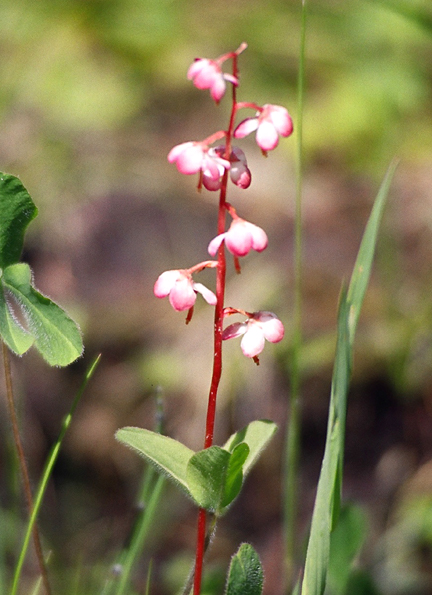- Pyrola
Taxobox
name = "Pyrola"

image_width = 250px
image_caption = "Pyrola asarifolia"
regnum =Plantae
divisio = Magnoliophyta
classis =Magnoliopsida
ordo =Ericales
familia =Ericaceae
genus = "Pyrola"
genus_authority = L.
subdivision_ranks = Species
subdivision = About 30 species, including:
"Pyrola americana " "Pyrola asarifolia " "Pyrola chlorantha " "Pyrola elliptica " "Pyrola grandiflora " "Pyrola incarnata " "Pyrola media " "Pyrola minor " "Pyrola norvegica " "Pyrola picta " "Pyrola rotundifolia ""Pyrola" (syn. "Pirola" Necker) is a genus of evergreen
herbaceous plant s in the familyEricaceae . Under the old Cronquist system it was placed in its own familyPyrolaceae , but genetic research showed it belonged in the familyEricaceae . The species are commonly known as wintergreen, a name shared with several other related and unrelated plants (seewintergreen for details). They are native to northern temperate andArctic regions.These wintergreens are characterised by the production of oil of wintergreen which gives the bruised plants a familiar "medicinal" smell. They are rather small plants with a rosette of simple orbicular or ovate leaves, with a
flower stem bearing generally rather laxraceme s of simple white, cream or pink flowers. The immediate distinguishing feature of "Pyrola" species is the flower style which is often curved, sticks out beyond the petals and is expanded below the stigma which itself is branched into severallobe s. To the casual observer the flower appears to have a small bell-clapper sticking out.Distribution
They are distributed across northern
temperate andarctic Europe ,Asia andNorth America . In North America they also occur down the western mountains south toCalifornia . Some populations inNew England may be introductions by early European settlers.Reproduction
Pyrolaceae, as part of the Ericales produce
pollen inanther s which open by apical pores. The pollen itself is produced in tetrads and is rather "sticky". Not surprisingly, wintergreens areinsect pollinated, most commonly by flies. The rather large and complex stigma may be an adaptation to ensure that small insects carrying pollen have an attractive landing place. The flowers are produced in the summer and the rather inconspicuous greenish seed capsules are produced in the autumn. The seeds are numerous and very small.Ecology
Wintergreens prefer damp and shady locations in woods or in dune slacks. They are often rather local in distribution but can be locally common especially in their more northern locations. Occurring often separately from the leaved varieties are the achlorophyllous, leafless forms of one or more of the typed species. Leaves, if present, can be narrow and reddish. These are
myco-heterotroph s and feed parasitically off of one or more of the local mycelia. Because of this parasitic action, the viability of the non-photosynthetic pyrola relies on the survival of the supporting mycelium. The pyrola group is one of a select few that can live both photosynthetically or not. This differentiation is not understood and if deciphered could explain how other obligate non-photosynthetic forest dwelling plants have crossed that evolutionary threshold.
Wikimedia Foundation. 2010.
